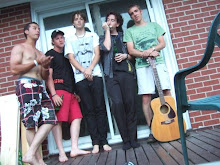I want to pack up a banjo, a harmonica, a glockenspiel, and two people willing to cram into tiny suitcases, and fly straight from Toronto to Reykjavík. Upon arrival, we will immediately locate the nearest winter garment distributor to purchase the thickest, most flamboyantly litskrúðugur woolen sweaters available.
Potential candidates must be willing to follow, without potential for alteration, this route which I created in MS Paint in no less than seven seconds:

As you can see, we will be visiting every town in the entire country. Our route will be relatively straightforward, with the exception of a single trip into the exact centre, carefully chosen to occur during the point of the trip where my finger slipped while using the paintbrush tool.
Our trip will begin at 11:59 on the evening of the 2010 summer solstice. It will end on an entirely arbitrary day of my choosing (whenever we get bored).
In order to ensure the trip goes smoothly, I have compiled a list of challenges we may encounter both throughout the planning stages, and eventual arrival.
Issue #1: Financial feasibility
Good news! While North America struggles through its own economic crisis, thanks to our valiant efforts to save ourselves, and ignorance toward other countries that really don't matter, the Icelandic economy no longer exists!

(Just in case your eyes don't focus illegible resolutions, that's a candid photo of "2009" and a "big fucking vertical line" drunk and locking lips at last night's party).
Now, I know what you're asking: "what does this mean for the price of a Big Mac in downtown Hafnarfjörður?" Well, while America's hat is paying more than $1.00 more on average than its head, an Icelandic Big Mac combo will run you roughly $0.00 depending on which recently unemployed fisherman you offer to help find a job.
Issue #2: The language barrier

My best efforts to translate the preceding text using the only Icelandic language resource I own, a Sigur rós calendar I purchased on the internet one night last summer while drunk, leads me to believe it translates in its entirely to the English equivalent of "August". Of course, I had my doubts, so I decided to ask Icelandic born Sam Neill where I might have gone wrong:

"I don't even know where to begin telling you what's wrong with just about everything you're talking about" was his response.
I was flabbergasted.
As much as I would love to be fluent in the language of the vikings, it turns out the vast majority of the country speaks English. Crisis averted (for now).
Fellow Jurassic Park actor Jeff Goldblum was unavailable for comment as he was busy trying to convince the world he wasn't dead for the fifth time.
Issue #3: Gnomes
FACT: The Lord of the Rings trilogy was a travelogue written by J.R.R. Tolkien about his trip to Iceland, mistaken for a work of fiction by his publishers.
PROOF: Figure 1.1: Composite drawing of "The Shire"

Figure 1.2: Actual photo of your average Icelandic dwelling

More than 80% of the population of Iceland believes in the existence of elves, gnomes, or magic pixies according to that website (and my mom during a family dinner at Swiss Chalet earlier this summer). Not even Iceland's great roadway expanses are exempt from gnomish influence. "Highway engineers in recent years have been forced to reroute roads around supposed elf dwellings". THIS IS WHAT ICELAND ACTUALLY BELIEVES.
To be entirely honest, during my trip to Iceland, I'd much rather face off against my musical shortcomings than to Gollum, or some kind of maliciously enchanted treant.
So mark your 2010 elven calendar for the 42nd eve of lairë. I'm already stuffing my piggy bank with valuable dwarven crystals.
See you there.
- Alex













